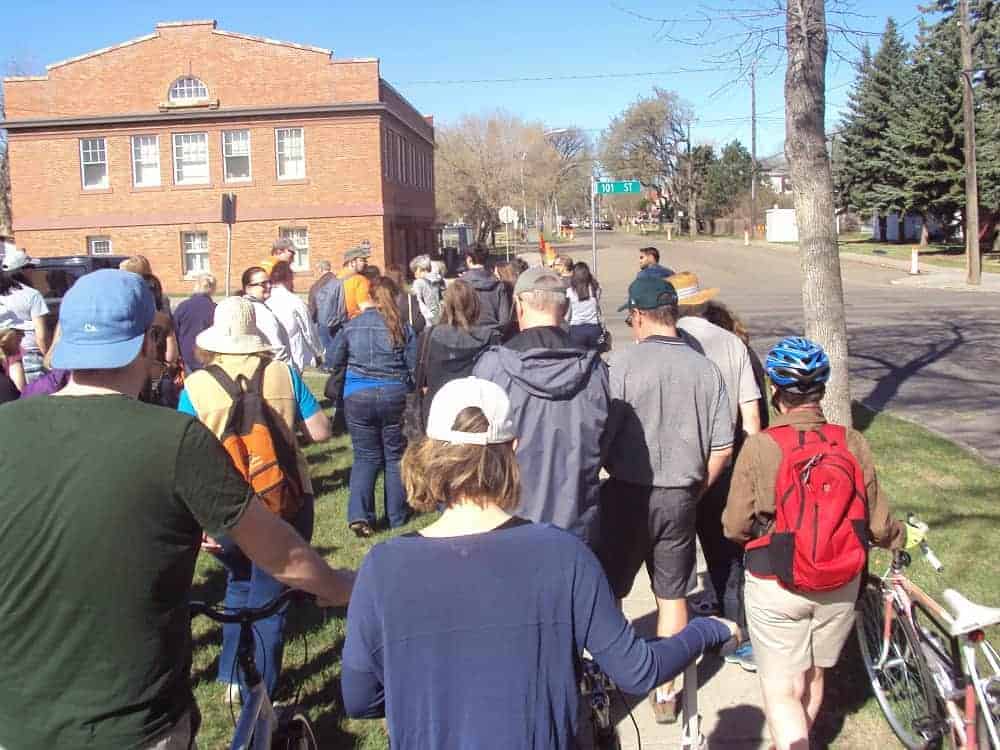Jane’s Walk illuminates local history
Over 40 people gathered on the corner of 101 Street and 112 Avenue on a beautiful Saturday afternoon in May to participate in the fourth annual Spruce Avenue Jane’s Walk.
Every year, thousands of free, independently organized and guided community walks happen on or around the birthday of Jane Jacobs, an urban planning icon and activist. Her work is an inspiration to urban enthusiasts like Spruce Avenue resident and walk leader Wesley Andreas.
For the past three years, Andreas explored the Polish history of the area, but this year he focused on neighbourhood house histories.
“I’ve been going on Jane’s Walks as a participant since they first spread beyond NYC and Toronto to Calgary in 2008 and I was always interested in leading one myself. When I moved to Edmonton, going on walks is how I first learned about the city,” said Andreas.
Andreas has been working on a community history project through Spruce Avenue Community League. Part of the project includes Andreas working with residents to research their heritage homes. In the past year, he secured funding to have historical plaques created for participating homes. Approximately 25 Spruce Avenue houses have these signboards listing the names and occupations of their original owners.
Nineteen of these heritage homes were listed on the handout that walkers received, along with nine other historical points of interest such as Spruce Avenue School and the fire (now ambulance) station rebuilt in 1966 to replace the 1911 original.
Andreas, an urban geographer by training, did extensive research and brought several historic photos to share. Early in the walk, he quoted a past resident named Eleanor Cleary, which caused some excitement in the group as two of the walkers announced that she was their great aunt. This was very much in keeping with the spirit of Jane’s Walks, which promote walkability, community, and education.
On 102 Street between 113 and 114 Avenues, Andreas stopped to discuss the impact of the Hudson’s Bay land sale in the 1930s, and to point out several houses built in the four-square style popular in the 1910s. Resident Ken Harcus said he and his family have bought and fixed up four different houses on that block since 1974, raising their five children in the process, one of whom now lives with his family next door to Ken and his wife Elaine.
On 101 Street, Andreas told the story of his own heritage home, which was one of three built by the Upright brothers who owned a tinsmithing business.
In the northwest quadrant of the neighbourhood, much of the land was used as an extension of the military bases at Blatchford Field during the Second World War. In fact, there was a plan to evacuate all Alaskan residents into this small area if it were ever under attack.
After the war, that land was redeveloped into the residential area it is now, but with the curving streets and bungalows popular in the 1950s and 60s. At the time, it was considered a style of infill not in keeping with the character of the neighbourhood and elicited considerable debate among residents not unlike, Andreas pointed out, the infill debates we have today in mature neighbourhoods.
Between the impressive turnout, the lovely weather, the skillful leadership of Andreas, and the enthusiastic participants, this Jane’s Walk was a success.
Featured Image: Spruce Avenue historian Wesley Andreas (in orange shirt) leads walk participants towards the 1912 North Telephone Exchange building, now serving as an Alberta Health Services research facility. | Samuel Murgatroyd







